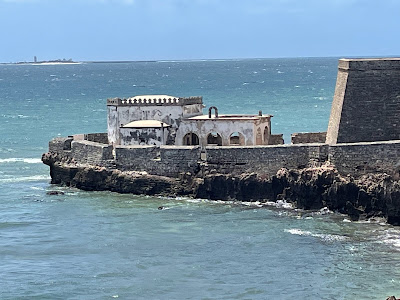Ilha de Mozambique
Here is a short history I found on Wikipedia which gives an overview of the island. I found it interesting.
The Portuguese established a port and a naval base in 1507 and built the Chapel of Nossa Senhora de Baluarte in 1522, now considered the oldest European building in the Southern Hemisphere.
The above two photos are from the inside of the church. We were told that only senior church and administrative officials were buried in the church (much like the floor of Westminster Abby).
During the 16th century, the Fort Sao Sebastiao was built (see two photos below), and the Portuguese settlement (now known as Stone Town ) became the capital of Portuguese East Africa.
Apart from the ancient fortifications, only half of the town is stone-built. The hospital, a majestic neo-classical building constructed in 1877 by the Portuguese, with a garden decorated with ponds and fountains, was repainted white after the Mozambican Civil War. For many years, it was the biggest hospital south of the Sahara.
With the opening of the Suez Canal, the island's fortunes waned. In 1898, the capital was moved to Lourenço Marques (now Maputo) on the mainland. By the middle of the 20th century, the new harbour of Nacala took most of the remaining business.
Today a good portion of the population is muslim. There are two mosques on the island and one Hindu Temple that is serviced by a lovely man . We visited both although we couldn't take photos inside.
The two photos below give you a feel of what it was like at the big mosque.
One of the most interesting things, at least to me, was the Memorial Garden near our hotel that was dedicated to all the people who were sent around the world to be slaves. We were told it was the site of where they loaded the people on to boats.

Currently there are almost no tourists visiting the island because of covid and there is little local travel. The town, which relies solely on tourism is definitely suffering economically. Lots of closed shops. While some of the major sites have been repaired, a significant part of the island's historic architectural integrity has deteriorated and still requires repair and reconstruction work.
It was interesting being there without many other tourists because we got a feel of what the island must have been like in the past but it was troubling to see all the street kids and the groups of people sitting in the shade (what little there was) waiting. Now that is just a fleeting impression because many people fish there and seafood is plentiful and delish! The photo below is a good example of a local fishing boat. You can't see the nets but they are made from rope of some kind with cork floats and the men throw them out from the boats - no mechanical fishing boats here.


















Comments
Post a Comment